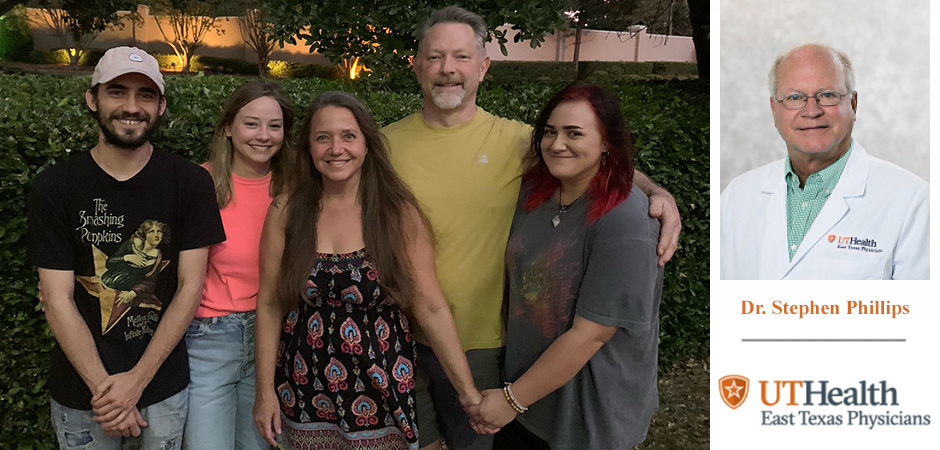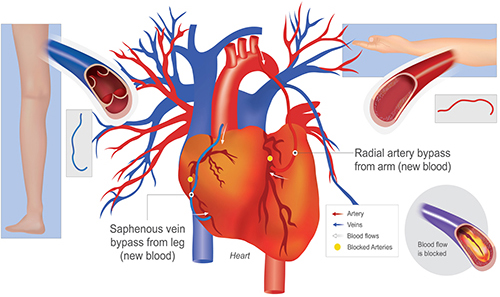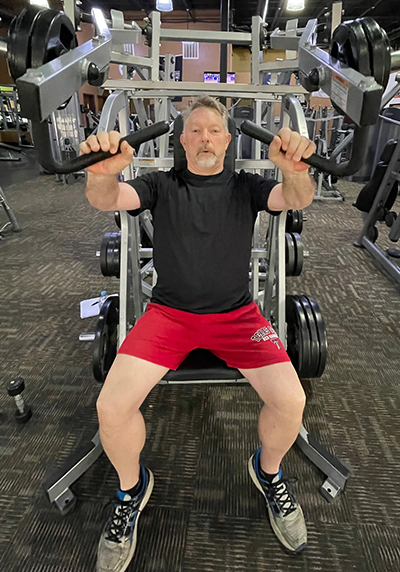
Rob Taylor was doing almost everything right.
For 15 years, the 59-year-old Bullard resident worked out in the gym at least three times a week with his personal trainer. He didn’t smoke and recently added playing in a senior softball league to his list of activities. Though he weighed around 250 pounds, Taylor carried it well on his six-foot frame.
Together with his wife and three children, the family kept up an active lifestyle and ate a “well-rounded, healthy diet” most of the time.
“However, about a third of the time,” recalled Taylor, “I didn’t eat very healthy. I love to eat and would go overboard with double-meat hamburgers and fries, large portions of beef and pork, fried chicken tenders, ice cream and other sweets. I rarely thought about portion sizes with my favorite foods.”
So when Taylor, a sales manager for a large food distributor, began to regularly feel lightheaded, he got concerned and scheduled an appointment with his primary care physician.
First signs of heart disease
“In the fall of 2022, I started experiencing some dizziness,” said Taylor. “At my next doctor’s appointment, I detailed my symptoms to the physician assistant, who said, ‘There may be an issue with your heart.’ Shortly thereafter, I started to wear a heart monitor.”
The data collected from the heart monitor suggested a blockage in Taylor’s heart, which may be interrupting the electric pulses that keep the heart working properly. In order for his heart to stay in regular rhythm, Aleksandr Korniyenko MD, a cardiologist at the UT Health East Texas Heart and Vascular Institute, implanted a pacemaker around Taylor’ heart. While he had never been diagnosed with high blood pressure, his doctor also prescribed a beta-blocker medication to lower his blood pressure and heart rate, making it easier for his heart to pump blood to the rest of his body.
“But throughout the spring, I continued to feel worn down,” Taylor said. “At my next appointment, I was ready to get off the medication because of the side effects. The physician assistant said that he could try other beta-blockers, but first, we needed to see if there were any blockages around my heart.”
Taylor went to the UT Health East Texas Heart and Vascular Institute for a heart catheterization, a procedure to see if he had any clogged arteries. Dr. Robert Carney used a thin, hollow tube that is guided through blood vessels to the heart. A dye injected in the vessels helps blockages to show up in X-rays.
Coronary bypass surgery
During Taylor’s catheterization, Dr. Carney determined that four of his arteries had blockages of various amounts. One was blocked 70%, while one near the top of his heart was blocked 85 to 90%. These results meant Taylor would have to undergo open-heart surgery to bypass the blockages.

“It was a shock to hear that Rob had to have quadruple bypass surgery,” said Taylor’s wife, Paula Taylor, RN, who has worked at UT Health Tyler for more than 20 years. “He is so healthy and not the typical candidate for heart bypass surgery.”
The surgery was scheduled for the next week with Dr. Stephen Phillips, who specializes in cardiothoracic surgery.
Another caregiver at the hospital interested in Taylor’s case was Baylee Taylor, RN, his oldest daughter.
“I have been working in the Cardiac Catheterization Lab at UT Health Tyler for many months,” said Baylee, “so I feel fortunate to know and work with the cardiologist and surgeon who took care of my dad. As nerve-racking as it was to find out suddenly that your dad needs open heart surgery, I felt so at peace knowing that Dr. Phillips would be doing his surgery.”
Taylor came through the surgery without any complications and was transferred to the cardiac care unit for recovery.
“Throughout Dad’s entire hospital experience, even as I was working, I knew he was getting the best possible care,” recalled Baylee. “I felt so blessed that I could break away from work for just a few minutes and check on him while he was in the hospital.”
After five days in the hospital, Taylor was discharged to be cared for at home by his two family nurses.
“During those first post-op weeks at home,” said Paula, “it pained him to watch me take care of his chores after my workday, such as cleaning our pool, feeding our horses, cooking and washing. But as soon as his stitches were removed, he started doing some laundry and cooking around the house.”
Caring for her husband, however, involved a different kind of stress than working at the hospital.
“Rob is a rule follower and mostly a good patient,” Paula said. “After being a nurse for 27 years and a mom for 25, I am used to the stress. However, this was 100 times more stressful because my patient at home was my best friend!”
Baylee also saw her father in a different light after his surgery.
“My dad is now fully recovered, has graduated from cardiac rehab and is doing better than ever,” said Baylee. “As much as I thought he would be a horrible patient, he actually behaved and took his recovery very seriously. He has learned a lot about good heart health and nutrition through the Pritikin Program.”
Pritikin Intensive Cardiac Rehab (ICR)
The Pritikin Intensive Cardiac Rehab (ICR) program at UT Health East Texas Rehabilitation Center provides education and support for cardiac patients who need to create a healthier lifestyle.
Unlike traditional cardiac rehab programs that focus mainly on physical exercise, the Pritikin program promotes effective recovery through the use of three interconnected disciplines:
- Safe, effective exercise
- Balanced eating plan
- Healthy mindset
These disciplines are introduced to program participants through immersive workshops, cooking classes and professionally-produced videos. The curriculum can be tailored to fit individual needs and is designed to support a variety of learning styles.
Through Pritikin ICR, participants learn how to:
- Implement significant lifestyle changes
- Create a personalized nutrition and exercise plan
- Lose weight using healthy, evidence-based strategies
- Make heart-healthy food choices when cooking or dining out
- Implement a variety of strategies for tobacco cessation (if needed)
- Manage stress in their daily lives
New, healthy lifestyle
 After a six-week recovery program that involved workouts and classes two hours a day, three times a week, Taylor was able to return to work, mindful of the lifestyle changes he needed to make.
After a six-week recovery program that involved workouts and classes two hours a day, three times a week, Taylor was able to return to work, mindful of the lifestyle changes he needed to make.
“A lot of my work is administrative, so I need to schedule time to exercise and of course eat healthy foods,” Taylor said. “I am back in my routine of meeting my personal trainer three times a week and doing other activities on three other days that week. I’ve lost 30 pounds since my surgery,” he said proudly.
Even though he has been in the food business for 40 years, he learned a lot during 18 classes in the Pritikin Program.
“They got very detailed about food, really looking at the sodium content in certain foods, the differences between natural sugars versus added sugars, plant-based proteins versus animal-based proteins, and more,” said Taylor. “That information has really changed my lifestyle.”
Now that his health has improved, Taylor and his wife have made travel plans for the fall.
“We have a fifth-wheel camper that we used to travel all over the southwest to watch our youngest daughter play college softball, so we like to travel,” Taylor said. “We are now setting our sights on visiting many of the state parks in Texas before I look at retirement in a few years.”
“We are just going to enjoy each and every day.”
For more information about our cardiac care services, visit the Cardiac Care webpage.
To learn more about Pritikin Intensive Cardiac Rehabilitation, visit the webpage.
